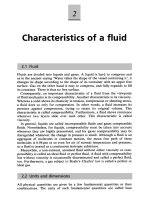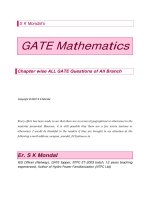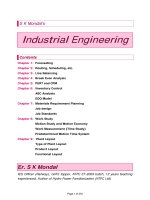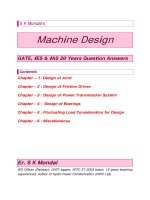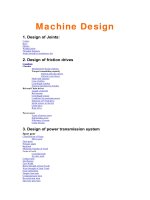- Trang chủ >>
- Khoa Học Tự Nhiên >>
- Vật lý
Fluid mechanics machines by s k mondal (olxam com)
Bạn đang xem bản rút gọn của tài liệu. Xem và tải ngay bản đầy đủ của tài liệu tại đây (4.48 MB, 307 trang )
S K Mondal’s
Fluid Mechanics
and Fluid Machines
Contents
Chapter
Chapter
Chapter
Chapter
Chapter
Chapter
Chapter
Chapter
Chapter
Chapter
Chapter
Chapter
Chapter
Chapter
Chapter
Chapter
Chapter
Chapter
Chapter
Chapter
Chapter
–
–
–
–
–
–
–
–
–
–
–
–
–
–
–
–
–
–
–
–
–
1: Properties of Fluids
2: Pressure and Its Measurements
3: Hydrostatic Forces on Surfaces
4: Buoyancy and Flotation
5: Fluid Kinematics
6: Fluid Dynamics
7: Dimensional & Model Analysis
8: Boundary Layer Theory
9: Laminar Flow
10: Turbulent Flow in Pipes
11: Flow Through Pipes
12: Flow Through Orifices and Mouthpieces
13: Flow Over Notches and Weirs
14: Flow Around Submerged Bodies-Drag and Lift
15: Compressible Flow
16: Flow Through Open Channel
17: Force Exerted on Surfaces
18: Hydraulic Turbine
19: Centrifugal Pump
20: Reciprocating Pumps
21: Miscellaneous Hydraulic Machines
Er. S K Mondal
IES Officer (Railway), GATE topper, NTPC ET-2003 batch, 12 years teaching
experienced, Author of Hydro Power Familiarization (NTPC Ltd)
Page 1 of 307
www.pdfgrip.com
Note
If you think there should be a change in
option, don’t change it by yourself send me a
at
I will send you complete explanation.
Copyright © 2007 S K Mondal
Every effort has been made to see that there are no errors (typographical or otherwise) in the
material presented. However, it is still possible that there are a few errors (serious or
otherwise). I would be thankful to the readers if they are brought to my attention at the
following e-mail address:
S K Mondal
Page 2 of 307
www.pdfgrip.com
Properties of Fluids
S K Mondal’s
1.
Chapter 1
Pr oper ties of Fluids
Contents of this chapter
1. Definition of Fluid
2. Characteristics of Fluid
3. Ideal and Real Fluids
4. Viscosity
5. Units of Viscosity
6. Kinematic Viscosity
7. Units of Kinematic Viscosity
8. Classification of Fluids
9. Effect of Temperature on Viscosity
10.
Effect of Pressure on Viscosity
11.
Surface Tension
12.
Pressure Inside a Curved Surface
13.
Capillarity
14.
Derive the Expression for Capillary Rise
Page 3 of 307
www.pdfgrip.com
S K Mondal’s
Properties of Fluids
Chapter 1
Theory at a Glance (for IES, GATE, PSU)
Definition of Fluid
A fluid is a substance which deforms continuously when subjected to external
shearing forces.
Characteristics of Fluid
1.
It has no definite shape of its own, but conforms to the shape of the containing
vessel.
2.
Even a small amount of shear force exerted on a fluid will cause it to undergo
a deformation which continues as long as the force continues to be applied.
3.
It is interesting to note that a solid suffers strain when subjected to shear
forces whereas a fluid suffers Rate of Strain i.e. it flows under similar
circumstances.
Concept of Continuum
The concept of continuum is a kind of idealization of the continuous description of
matter where the properties of the matter are considered as continuous functions
of space variables. Although any matter is composed of several molecules, the
concept of continuum assumes a continuous distribution of mass within the matter
or system with no empty space, instead of the actual conglomeration of separate
molecules.
Describing a fluid flow quantitatively makes it necessary to assume that flow
variables (pressure, velocity etc.) and fluid properties vary continuously from one
point to another. Mathematical descriptions of flow on this basis have proved to be reliable
and treatment of fluid medium as a continuum has firmly become established.
For example density at a point is normally defined as
Here Δ is the volume of the fluid element and m is the mass
If Δ is very large ρ is affected by the inhomogeneities in the fluid medium.
Considering another extreme if Δ is very small, random movement of atoms (or
molecules) would change their number at different times. In the continuum
approximation point density is defined at the smallest magnitude of Δ , before
statistical fluctuations become significant. This is called continuum limit and is
denoted by Δ c.
One of the factors considered important in determining the validity of continuum
model is molecular density. It is the distance between the molecules which is
Page 4 of 307
www.pdfgrip.com
S K Mondal’s
Properties of Fluids
Chapter 1
characterised by mean free path ( λ ). It is calculated by finding statistical average
distance the molecules travel between two successive collisions. If the mean free
path is very small as compared with some characteristic length in the flow domain
(i.e., the molecular density is very high) then the gas can be treated as a
continuous medium. If the mean free path is large in comparison to some
characteristic length, the gas cannot be considered continuous and it should be
analysed by the molecular theory.
A dimensionless parameter known as Knudsen number, Kn = λ / L, where λ is the
mean free path and L is the characteristic length. It describes the degree of
departure from continuum.
Usually when Kn> 0.01, the concept of continuum does not hold good.
Beyond this critical range of Knudsen number, the flows are known as
slip flow (0.01 < Kn < 0.1),
transition flow (0.1 < Kn < 10) and
free-molecule flow (Kn > 10).
However, for the flow regimes considered in this course, K n is always less than 0.01
and it is usual to say that the fluid is a continuum.
Other factor which checks the validity of continuum is the elapsed time between
collisions. The time should be small enough so that the random statistical
description of molecular activity holds good.
In continuum approach, fluid properties such as density, viscosity, thermal
conductivity, temperature, etc. can be expressed as continuous functions of space
and time.
Ideal and Real Fluids
1. Ideal Fluid
An ideal fluid is one which has
no viscosity
no surface tension
and incompressible
2. Real Fluid
An Real fluid is one which has
viscosity
surface tension
and compressible
Naturally available all fluids are real fluid.
Viscosity
Definition: Viscosity is the property of a fluid which determines its resistance to
shearing stresses.
Cause of Viscosity: It is due to cohesion and molecular momentum exchange
between fluid layers.
Newton’s Law of Viscosity: It states that the shear stress (τ) on a fluid element
layer is directly proportional to the rate of shear strain.
The constant of proportionality is called the co-efficient of viscosity.
Page 5 of 307
www.pdfgrip.com
S K Mondal’s
Properties of Fluids
Chapter 1
When two layers of fluid, at a distance ‘dy’
apart, move one over the other at different
velocities, say u and u+du.
Velocity gradient =
du
dy
According to Newton’s law
τ∞
du
dy
Velocity Variation near a solid
boundary
or
du
τ=µ
dy
Where
µ
= constant of proportionality and is known as co-efficient of Dynamic
viscosity or only Viscosity
Thus viscosity may also be defined as the shear stress required
As
µ=
τ
du
dy
producing unit rate of shear strain.
Units of Viscosity
S.I. Units: Pa.s or N.s/m2
C.G.S Unit of viscosity is Poise= dyne-sec/cm2
One Poise= 0.1 Pa.s
1/100 Poise is called centipoises.
Dynamic viscosity of water at 20oC is approx= 1 cP
Kinematic Viscosity
It is the ratio between the dynamic viscosity and density of fluid and denoted by
Mathematically
ν=
dynamic viscosity µ
=
density
ρ
Units of Kinematic Viscosity
S.I units: m2/s
C.G.S units: stoke = cm2/sec
One stoke = 10-4 m2/s
Page 6 of 307
www.pdfgrip.com
Properties of Fluids
S K Mondal’s
Chapter 1
Thermal diffusivity and molecular diffusivity have same dimension, therefore, by
analogy, the kinematic viscosity is also referred to as the momentum diffusivity of
the fluid, i.e. the ability of the fluid to transport momentum.
Classification of Fluids
1. Newtonian Fluids
These fluids follow Newton’s viscosity equation.
For such fluids viscosity does not change with rate of deformation.
2. Non- Newtonian Fluids
These fluids does not follow Newton’s viscosity equation.
Such fluids are relatively uncommon e.g. Printer ink, blood, mud, slurries, polymer
solutions.
Non-Newtonian Fluid
(
)
τ ≠µ
du
dy
Purely Viscous Fluids
Time - Independent
1. Pseudo plastic Fluids
n
Visco-elastic
du
τ = µ + f (t )
dy
Example: Blood, milk
Example:
Printer
du
τ = µ ; n > 1
dy
crude oil
Example: Butter
du
τ = µ + f (t )
Ideal
dy
Plastic Fluid
n
f(t)is
n
increasing
Example: Rare liquid solid
Water
Example: Liquid-
ink; combinations
pipe flow.
2. Rheopectic Fluids
or
du
+ αE
dy
solid
decreasing
n
Example:
τ =µ
f(t)is
2. Dilatant Fluids
du
τ = τ o + µ
dy
Fluids
n
du
τ = µ ; n < 1
dy
3. Bingham
Fluids
Visco-elastic
Time - Dependent
1.Thixotropic Fluids
suspension
suspensions of clay and
flash
Page 7 of 307
www.pdfgrip.com
in
S K Mondal’s
Properties of Fluids
Chapter 1
Fig. Shear stress and deformation rate relationship of different fluids
Effect of Temperature on Viscosity
With increase in temperature
Viscosity of liquids decrease
Viscosity of gasses increase
Note: 1. Temperature responses are neglected in case of Mercury.
2. The lowest viscosity is reached at the critical temperature.
Effect of Pressure on Viscosity
Pressure has very little effect on viscosity.
But if pressure increases intermolecular gap decreases then cohesion increases so
viscosity would be increase.
Surface tension
Surface tension is due to cohesion between particles at the surface.
Capillarity action is due to both cohesion and adhesion.
Surface tension
The tensile force acting on the surface of a liquid in contact with a gas or on the
surface between two immiscible liquids such that the contact surface behaves like
a membrane under tension.
Page 8 of 307
www.pdfgrip.com
S K Mondal’s
Properties of Fluids
Chapter 1
Pressure Inside a Curved Surface
For a general curved surface with radii of curvature r1 and r2 at a point of interest
1 1
∆p = σ +
r1 r2
a. Pressure inside a water droplet,
∆p =
4σ
d
b. Pressure inside a soap bubble,
∆p =
8σ
d
c. Liquid jet.
∆p =
2σ
d
Capillarity
A general term for phenomena observed in liquids due to inter-molecular attraction
at the liquid boundary, e.g. the rise or depression of liquids in narrow tubes. We
use this term for capillary action.
Capillary rise and depression phenomenon depends upon the surface tension of the
liquid as well as the material of the tube.
1. General formula,
h=
4σ cosθ
ρ gd
2. For water and glass θ = 0o,
h=
4σ
ρ gd
3. For mercury and glass θ = 138o ,
h=−
4σ cos42o
ρ gd
(h is negative indicates capillary depression)
Note: If adhesion is more than cohesion, the wetting tendency is more and the
angle of contact is smaller.
Page 9 of 307
www.pdfgrip.com
S K Mondal’s
Properties of Fluids
Chapter 1
Derive the Expression for Capillary Rise
σ
Let us consider a glass tube of small
diameter ‘d’ opened at both ends and
is inserted vertically in a liquid, say
water. The liquid will rise in the tube
above the level of the liquid.
Let, d = diameter of the capillary
tube.
h = height of capillary rise.
= angle of contact of the water
θ
θ
σ
π
θ< 2
h
d
surface.
= surface tension force for
σ
Fig. Capillary rise (As in water)
Adhesion > cohesion (Meniscus concave)
unity length.
= density of liquid.
ρ
g = acceleration due to gravity.
Under a state of equilibrium,
Upward surface tension force (lifting force) = weight of the water column in
the tube (gravity force)
or
π d. σ cos θ =
π d2
×h× ρ ×g
4
or
4 σ cos θ
h=
ρ gd
If
, h will be negative, as in the case of mercury
θ> π
=
θ
2
capillary
138°
depression occurred.
Question:
A circular disc of diameter ‘d’ is slowly rotated in a liquid of
large viscosity ‘ ’ at a small distance ‘t’ from the fixed
µ
surface. Derive the expression for torque required to maintain
the speed ‘ ’.
ω
Answer:
Radius, R = d/2
Consider an elementary circular ring of
radius r and thickness dr as shown.
Area of the elements ring =
The shear stress at ring,
Page 10 of 307
www.pdfgrip.com
Properties of Fluids
S K Mondal’s
Chapter 1
τ=µ
du
V
rω
=µ =µ
dy
t
t
Shear force on the elements ring
dF = τ× area of thering= τ× 2π r dr
Torque on the
ring= dFìr
dT = à
r
ì 2 r dr ×r
t
Total torque, T =
∴
R
µr ω
× 2 π r dr.r
t
0
∫ dT = ∫
=
=
R
2 πµ ω 3
r dr
t ∫0
T=
Question:
=
πµ ω 4
R
2t
( )
πµ d
ì
2
2t
4
à d4
32t
A solid cone of radius R and vortex angle 2
is to rotate at an
θ
angular
Answer:
velocity,
ω
.
An
oil
of
dynamic
viscosity
µ
and
thickness ‘t’ fills the gap between the cone and the housing.
Determine the expression for Required Torque.
[IES-2000;
AMIE (summer) 2002]
Consider
an
elementary
ring
of
bearing
surface
of
radius r. at a distance
h from the apex. and
is the radius at
let
r + dr
h + dh distance
Bearing area =
2π r dl
=
2π r .
dr
sin θ
Page 11 of 307
www.pdfgrip.com
Properties of Fluids
S K Mondal’s
Chapter 1
Shear stress
τ=µ
du
V
rω
=µ =µ
dy
t
t
Tangential resistance on the ring
∴
dF = shear stress × area of the ring
=
ω
dr
× 2πr
t
sin θ
µr
Torque due to the force dF
∴
dT = dF.r
dT =
2πµ 3
ìr dr
t sin
Total torque
R
2 à 3
ìr dr
t sin θ
0
T = ∫ dT = ∫
=
2 π µ ω R4 à R 4
ì
=
t sin 4
2t sin
Page 12 of 307
www.pdfgrip.com
S K Mondal’s
Properties of Fluids
Chapter 1
OBJECTIVE QUESTIONS (GATE, IES, IAS)
Previous 20-Years GATE Questions
Viscosity
GATE-1. The SI unit of kinematic viscosity ( ) is:
[GATE-2001]
υ
(a) m2/s
(b) kg/m-s
(c) m/s2
(d) m3/s2
GATE-1. Ans. (a)
GATE-2. Kinematic viscosity of air at 20°C is given to be 1.6 × 10-5m2/s. Its
kinematic viscosity at 70°C will be vary approximately
[GATE1999]
(b) 1.6 10-5m2/s
(c) 1.2 10-5m2/s
(d)
3.2 10(a) 2.2 10-5m2/s
×
×
×
×
5
m2/s
GATE-2. Ans. (a) Viscosity of gas increases with increasing temperature.
Newtonian Fluid
GATE-3. For a Newtonian fluid
[GATE-2006; 1995]
(a) Shear stress is proportional to shear strain
(b) Rate of shear stress is proportional to shear strain
(c) Shear stress is proportional to rate of shear strain
(d) Rate of shear stress is proportional to rate of shear strain
GATE-3. Ans. (c)
Surface Tension
GATE-4. The dimension of surface tension is:
(a) ML-1
(b) L2T-1
GATE-4. Ans. (d)
(c) ML-1T1
[GATE-1996]
(d) MT-2
GATE-5. The dimensions of surface tension is:
[GATE-1995]
(a) N/m2
(b) J/m
(c) J/m2
(d) W/m
GATE-5. Ans. (c) The property of the liquid surface film to exert a tension is called
the surface tension. It is the force required to maintain unit length of the
film in equilibrium. In Sl units surface tension is expressed in
J
N / m
.
m2
In metric gravitational system of units it is expressed in kg(f)/cm or
kg(f)/m.
Page 13 of 307
www.pdfgrip.com
S K Mondal’s
Properties of Fluids
Chapter 1
Previous 20-Years IES Questions
Fluid
IES-1.
Assertion (A): In a fluid, the rate of deformation is far more
important than the total deformation itself.
Reason (R): A
fluid continues to deform so long as the external forces are
applied.
[IES-1996]
(a) Both A and R are individually true and R is the correct explanation of
A
(b) Both A and R are individually true but R is not the correct explanation
of A
(c) A is true but R is false
(d) A is false but R is true
IES-1. Ans. (a) Both A and R correct and R is correct explanation for A
IES-2.
Assertion (A): In a fluid, the rate of deformation is far more
important than the total deformation itself.
[IES-2009]
Reason (R): A fluid continues to deform so long as the external
forces are applied.
(a) Both A and R are individually true and R is the correct explanation of
A.
(b) Both A and R are individually true but R is not the correct explanation
of A.
(c) A is true but R is false.
(d) A is false but R is true.
IES-2. Ans. (a) This question is copied from
Characteristics of fluid
1. It has no definite shape of its own, but conforms to the shape
of the containing vessel.
2. Even a small amount of shear force exerted on a fluid will
cause it to undergo a deformation which continues as long as
the force continues to be applied.
3. It is interesting to note that a solid suffers strain when
subjected to shear forces whereas a fluid suffers Rate of
Strain i.e. it flows under similar circumstances.
Viscosity
IES-3.
IES-3.
IES-4.
Newton’s law of viscosity depends upon the
[IES-1998]
(a) Stress and strain in a fluid
(b) Shear stress, pressure and
velocity
(c) Shear stress and rate of strain (d) Viscosity and shear stress
Ans.
Newton's law of viscosity
(c)
du
τ =µ
where, τ → Shear stress
dy
du
→ Rate of strain
dy
What is the unit of dynamic viscosity of a fluid termed 'poise'
equivalent to?
[IES-2008]
Page 14 of 307
www.pdfgrip.com
Properties of Fluids
S K Mondal’s
Chapter 1
(a) dyne/cm2
(d) gm-cm/s
IES-4. Ans. (c)
(c) dyne s/cm2
(b) gm s/cm
IES-5.
The shear stress developed in lubricating oil, of viscosity 9.81
poise, filled between two parallel plates 1 cm apart and moving
with relative velocity of 2 m/s is:
[IES-2001]
(a) 20 N/m2
(b) 196.2 N/m2
(c) 29.62 N/m2
(d) 40 N/m2
IES-5. Ans. (b) du=2 m/s; dy= 1cm = 0.01 m; = 9.81 poise = 0.981 Pa.s
à
Therefore ( ) =
à du
dy
= 196.2 N/m2
= 0.981 ì
2
0.01
IES-6.
What are the dimensions of kinematic viscosity of a fluid?
[IES2007]
(a) LT-2
(b) L2T-1
(c) ML-1T-1
(d)ML2 -2
T
IES-6. Ans. (b)
An oil of specific gravity 0.9 has viscosity of 0.28 Strokes at 380C.
What will be its viscosity in Ns/m2?
[IES-2005]
(a) 0.2520
(b) 0.0311
(c) 0.0252
(d)
0.0206
IES-7. Ans. (c) Specific Gravity = 0.9 therefore Density = 0.9 × 1000 =900 kg/m3
One Stoke = 10-4 m2/s
= 900 × 0.28 × 10-4 = 0.0252 Ns/m2
Viscosity ( ) =
IES-7.
µ
ρ ν
IES-8.
Decrease in temperature, in general, results in
[IES-1993]
(a) An increase in viscosities of both gases and liquids
(b) A decrease in the viscosities of both liquids and gases
(c) An increase in the viscosity of liquids and a decrease in that of gases
(d) A decrease in the viscosity of liquids and an increase in that of gases
IES-8. Ans. (c) The viscosity of water with increase in temperature decreases and
that of air increases.
IES-9.
Assertion (A): In general, viscosity in liquids increases and in
gases it decreases with rise in temperature.
[IES-2002]
Reason (R): Viscosity is caused by intermolecular forces of
cohesion and due to transfer of molecular momentum between
fluid layers; of which in liquids the former and in gases the later
contribute the major part towards viscosity.
(a) Both A and R are individually true and R is the correct explanation of
A
(b) Both A and R are individually true but R is not the correct explanation
of A
(c) A is true but R is false
(d) A is false but R is true
IES-9. Ans. (d)
Page 15 of 307
www.pdfgrip.com
S K Mondal’s
Properties of Fluids
Chapter 1
Non-Newtonian Fluid
IES-10. If the Relationship between the shear stress
shear strain
is expressed as
du
dy
τ
and the rate of
then the fluid with
du
τ = µ
dy
n
exponent n>1 is known as which one of the following? [IES-2007]
(a) Bingham Plastic
(b) Dilatant Fluid
(c) Newtonian Fluid
(d) Pseudo plastic Fluid
IES-10. Ans. (b)
IES-11. Match List-I (Type of fluid) with List-II (Variation of shear stress)
and select the correct answer:
[IES-2001]
List-I
List-II
A. Ideal fluid
1. Shear stress varies linearly with the rate of
strain
B. Newtonian fluid
2. Shear stress does not vary linearly with
the rate of strain
C. Non-Newtonian fluid
3. Fluid behaves like a solid until a minimum
yield stress beyond which it exhibits a
linear relationship between shear stress
and the rate of strain
D. Bingham plastic
4. Shear stress is zero
Codes:
A
B
C
D
A
B
C
D
(a)
3
1
2
4
(b) 4
2
1
3
(c) 3
2
1
4
(d) 4
1
2
3
IES-11. Ans. (d)
IES-12. In an experiment, the following shear stress - time rate of shear
strain values are obtained for a fluid:
[IES-2008]
Time rate of shear strain (1/s): 0
2
3
4
Shear stress (kPa):
0
1.4
2.6
4
(a) Newtonian fluid
(b) Bingham plastic
(c) Pseudo plastic
(d) Dilatant
IES-12.
Ans.
(d)
IES-13. Match List-I (Rheological Equation) with List-II (Types of Fluids)
and select the correct the answer:
[IES-2003]
List-I
List-II
A.
, n=1
1. Bingham plastic
τ = µ (du / dy) n
Page 16 of 307
www.pdfgrip.com
Properties of Fluids
S K Mondal’s
B.
τ = µ (du / dy)
Chapter 1
, n<1
2. Dilatant fluid
, n>1
3. Newtonian fluid
n
C.
τ = µ (du / dy) n
D.
+
τ = τ0
Codes:
(a)3
(c) 3
IES-13. Ans. (c)
µ
(du/dy)n, n=1
A
2
4
B
4
2
4. Pseudo-plastic fluid
C
1
1
D
(b)
(d)
4
4
A
1
2
B
2
1
C
3
3
D
IES-14. Assertion (A): Blood is a Newtonian fluid.
[IES-2007]
Reason (R): The rate of strain varies non-linearly with shear
stress for blood.
(a) Both A and R are individually true and R is the correct explanation of
A
(b) Both A and R are individually true but R is not the correct explanation
of A
(c) A is true but R is false
(d) A is false but R is true
IES-14. Ans. (d) A is false but R is true.
IES-15. Match List-I with List-II and select the correct answer. [IES-1995]
List-I (Properties of fluids) List-II (Definition/ Results)
A. Ideal fluid
1. Viscosity does not change with rate of
deformation
B. Newtonian fluid
2. Fluid of zero viscosity
C.
3. Dynamic viscosity
µ/ρ
D. Mercury in glass
Code:A
(a)1
(c) 2
IES-15. Ans. (d)
B
2
1
C
4
3
D
6
6
4. Capillary depression
5. Kinematic viscosity
6. Capillary rise
A
B
C
(b)
1
2
3
(d)
2
1
5
D
4
4
Surface Tension
IES-16. Surface tension is due to
[IES-1998]
(a)Viscous forces
(b)Cohesion
(c) Adhesion
(d)The difference between adhesive
and cohesive forces
IES-16. Ans. (b) Surface tension is due to cohesion between liquid
particles at the surface, where as capillarity is due to both
cohesion and adhesion. The property of cohesion enables a liquid
to resist tensile stress, while adhesion enables it to stick to
another body.
IES-17. What is the pressure difference between inside and outside of a
droplet of water?
[IES-2008]
Page 17 of 307
www.pdfgrip.com
S K Mondal’s
(a) 2
Properties of Fluids
Chapter 1
(b) 4
σ /d
(c) 8
σ /d
(d)
12
σ /d
σ /d
Where '
σ
' is the surface tension and’d’ is the diameter of the droplet.
IES-17. Ans. (b) Pressure inside a water droplet,
∆p =
4σ
d
IES-18. If the surface tension of water-air interface is 0.073 N/m, the
gauge pressure inside a rain drop of 1 mm diameter will be: [IES1999]
(a) 0.146N/m2
(b) 73N/m2
(c) 146N/m2
(d) 292
2
N/m
IES-18. Ans. (d) P =
4σ 4 × 0.073
=
= 292 N / m 2
d
0.001
IES-19. What is the pressure inside a soap bubble, over the atmospheric
pressure if its diameter is 2 cm and the surface tension is 0·1
N/m?
[IES-2008]
(a) 0·4 N/m2 (b) 4·0 N/m2
(c) 40.0 N/m2
(d) 400.0 N/m2
IES-19. Ans. (c)
Capillarity
IES-20. The capillary rise at 200C in clean glass tube of 1 mm diameter
containing water is approximately
[IES-2001]
(a) 15 mm
(b) 50 mm
(c) 20 mm
(d) 30 mm
IES-20. Ans. (d)
h=
4σ
4 × 0.073
=
≈ 30 mm
ρgd 1000× 9.81× 0.001
IES-21. Which one of the following is correct?
[IES-2008]
The capillary rise on depression in a small diameter tube is
(a) Directly proportional to the specific weight of the fluid
(b) Inversely proportional to the surface tension
(c) Inversely proportional to the diameter
(d) Directly proportional to the surface area
IES-21. Ans. (c) The capillary rise on depression is given by,
h=
Page 18 of 307
www.pdfgrip.com
4σ cos θ
ρgd
S K Mondal’s
Properties of Fluids
Chapter 1
IES-22. A capillary tube is inserted in mercury kept in an open container.
Assertion (A): The mercury level inside the tube shall rise above
the level of mercury outside.
[IES-2001]
Reason (R): The cohesive force between the molecules of
mercury is greater than the adhesive force between mercury and
glass.
(a) Both A and R are individually true and R is the correct explanation of
A
(b) Both A and R are individually true but R is not the correct explanation
of A
(c) A is true but R is false
(d) A is false but R is true
IES-22. Ans. (d) Mercury shows capillary depression.
IES-23. What is the capillary rise in a narrow two-dimensional slit of
width 'w'?
(a) Half of that in a capillary tube of diameter ‘w’
[IES-2009]
(b) Two-third of that in a capillary tube of diameter 'w'
(c) One-third of that in a capillary tube of diameter 'w'
(d) One-fourth of that in a capillary tube of diameter 'w'
IES-23. Ans. (a)
IES-24. Assertion (A): A narrow glass tube when immersed into mercury
causes capillary depression, and when immersed into water
causes capillary rise.
[IES-2009]
Reason (R): Mercury is denser than water.
(a) Both A and R are individually true and R is the correct explanation of
A.
(b) Both A and R are individually true but R is not the correct explanation
of A.
(c) A is true but R is false.
(d) A is false but R is true.
IES-24. Ans. (b) Causes of capillary depression: Adhesion is less than cohesion,
the wetting tendency is less and the angle of contact is high.
IES-25. Consider the following statements related to the fluid properties:
1. Vapour pressure of water at 373 K is 101·5 × 103 N/m2.
Page 19 of 307
www.pdfgrip.com
S K Mondal’s
Properties of Fluids
Chapter 1
2. Capillary height in cm for water in contact with glass tube and
air is (tube dia)/0·268.
3. Blood is a Newtonian fluid
Which of the statements given above is/are correct?
[IES-2008]
(a) 1 only
(b) 1 and 3
(c) 1 and 2
(d) 2 only
IES-25. Ans. (a) Vapour pressure of water at 373 K means 100 oC is one
atmosphere = 1.01325 bar = 101.325 × 103 N/m2.
Capillary height in cm for water in contact with glass tube =
0.3
d
For water and glass
θ = 0°, h =
4σ
ρgd
Blood is a pseudoplastic fluid.
Where
n
du
τ = µ ; n <1
dy
Compressibility and Bulk Modulus
IES-26. Which one of the following is the bulk modulus K of a fluid?
(Symbols have the usual meaning)
[IES-1997]
(b)
(c)
(d)
(a)
ρ
IES-26.
dp
dρ
Ans.
(a)
ρdρ
dp
dp
ρdρ
Bulk modulus
dp
K =−
and
dv
v
dp
∴ K =−
−d ρ
ρ2
1
ρ
ρ dρ
K =
dρ
v=
dρ
ρdp
1
ρ
∴ dv = −
dρ
ρ2
IES-27. When the pressure on a given mass of liquid is increased from
3.0 MPa to 3.5 MPa, the density of the liquid increases from 500
kg/m3 to 501 kg/m3.What is the average value of bulk modulus of
the liquid over the given pressure range?
[IES-2006]
(a) 700 MPa
(b) 600MPa
(c) 500MPa
(d) 250MPa
IES-27. Ans.(d)
500 × (3.5 − 3.0)
= 250 MPa
(501− 500)
Page 20 of 307
www.pdfgrip.com
S K Mondal’s
Properties of Fluids
Chapter 1
Vapour Pressure
IES-28. Which Property of mercury is the main reason for use in
barometers?
(a) High Density
(b) Negligible Capillary effect
(c) Very Low vapour Pressure (d) Low compressibility
[IES-2007]
IES-28. Ans. (c)
IES-29. Consider the following properties of a fluid:
[IES-2005]
1. Viscosity
2. Surface tension
3. Capillarity
4. Vapour pressure
Which of the above properties can be attributed to the flow of jet
of oil in an unbroken stream?
(a) 1 only
(b) 2 only
(c) 1 and 3
(d) 2 and 4
IES-29. Ans. (b) Surface tension forces are important in certain classes of
practical problems such as,
1. Flows in which capillary waves appear
2. Flows of small jets and thin sheets of liquid injected by a nozzle in air
3. Flow of a thin sheet of liquid over a solid surface.
Here the significant parameter for dynamic similarity is the magnitude
ratio of the surface tension force to the inertia force. And we must use
Weber number for similarity. Therefore the answer will be surface
tension.
And you also know that Pressure inside a Liquid jet.
.
∆p =
2σ
d
IES-30. Match List-I with List-II and select the correct answer using the
code given below the lists:
[IES-2008]
List-I (Variable)
List-II
(Dimensional
Expression)
A. Dynamic Viscosity
1. M L2 T-3
B. Moment of momentum
2. M L-1 T-2
C. Power
3. M L-1 T-1
D. Volume modulus of elasticity
4. M L2 T-2
5. M L2 T-1
Codes:
A
B
C
D
A
B
C
D
(a)
1
4
2
3
(b)
3
5
1
2
(c)
1
5
2
3
(d)
3
4
1
2
IES-30. Ans. (b)
Previous 20-Years IAS Questions
Fluid
IAS-1.
Which one of the following sets of conditions clearly apply to an
ideal fluid?
[IAS-1994]
(a) Viscous and compressible
(b) Non-viscous and incompressible
(c) Non-viscous and compressible (d) Viscous and incompressible
IAS-1. Ans. (b)
Page 21 of 307
www.pdfgrip.com
S K Mondal’s
Properties of Fluids
Chapter 1
Viscosity
When a flat plate of 0.1 m2 area is pulled at a constant velocity of
30 cm/sec parallel to another stationary plate located at a
distance 0.01 cm from it and the space in between is filled with a
fluid of dynamic viscosity = 0.001 Ns/m2, the force required to be
applied is:
[IAS-2004]
(a) 0.3 N
(b) 3 N
(c) 10 N
(d) 16 N
IAS-2. Ans. (a) Given, µ = 0.001 Ns/m2 and du = (V – 0) = 30 cm/sec = 0.3 m/s
and distance (dy) = 0.01 cm = 0.0001 m
Therefore, Shear stress ( ) =
IAS-2.
τ
Force required (F) =
µ
du
Ns ( 0.3m/s )
= 0.001 2 ×
=3N/m 2
dy
m ( 0.0001m )
× A = 3 × 0.1 = 0.3 N
τ
Newtonian Fluid
IAS-3.
In a Newtonian fluid, laminar flow between two parallel plates,
the ratio ( ) between the shear stress and rate of shear strain is
τ
given by
(a)
µ d 2µ
dy2
du
µ
dy
1
(b)
[IAS-1995]
(d)
(c)
µ
du
dy
du
µ
dy
2
2
IAS-3. Ans. (b)
IAS-4.
Consider the following statements:
[IAS-2000]
1. Gases are considered incompressible when Mach number is
less than 0.2
2. A Newtonian fluid is incompressible and non-viscous
3. An ideal fluid has negligible surface tension
Which of these statements is /are correct?
(a) 2 and 3
(b) 2 alone
(c) 1 alone
(d) 1 and 3
IAS-4. Ans. (d)
Non-Newtonian Fluid
IAS-5.
The relations between shear stress ( ) and velocity gradient for
τ
ideal fluids, Newtonian fluids and non-Newtonian fluids are given
below. Select the correct combination.
[IAS-2002]
Page 22 of 307
www.pdfgrip.com
Properties of Fluids
S K Mondal’s
(a)
(b)
(c)
τ
τ
τ
=0;
=0;
=
µ
=
τ
=
τ
.(
τ
=
µ
µ
.(
.(
)
;
du τ
dy
)
=
τ
;
=
du τ
)
dy
=
du τ
.(
;
du 2
)
dy
;
dy
(d)
µ
Chapter 1
µ
=
µ
du 3
)
dy
.(
µ
du 2
)
dy
.(
µ
.(
;
du
)
dy
2
.(
τ
;
du
)
dy
2
τ
=
µ
.(
du 3
)
dy
=0
IAS-5. Ans. (b)
IAS-6.
Fluids that require a gradually increasing shear stress to
maintain a constant strain rate are known as
[IAS-1997]
(a) Rhedopectic fluids
(b) Thixotropic fluids
(c) Pseudoplastic fluids
(d) Newtonian fluids
where f(t) is increasing
IAS-6. Ans. (a)
n
du
τ = µ + f (t )
dy
Surface Tension
IAS-7.
At the interface of a liquid and gas at rest, the pressure is: [IAS1999]
(a) Higher on the concave side compared to that on the convex side
(b) Higher on the convex side compared to that on the concave side
(c) Equal to both sides
(d) Equal to surface tension divided by radius of curvature on both sides.
IAS-7. Ans. (a)
Vapour Pressure
IAS-8.
Match List-I (Physical properties of fluid) with List-II
(Dimensions/Definitions) and select the correct answer:
[IAS2000]
List-I
List-II
A. Absolute viscosity
1. du/dy is constant
B. Kinematic viscosity
2. Newton per metre
C. Newtonian fluid
3. Poise
D. Surface tension
4. Stress/Strain is constant
5. Stokes
Codes:
A
B
C
D
A
B
C
D
(a)5
3
1
2
(b)
3
5
2
4
(c) 5
3
4
2
(d)
3
5
1
2
IAS-8. Ans. (d)
Page 23 of 307
www.pdfgrip.com
S K Mondal’s
Properties of Fluids
Chapter 1
Answers with Explanation (Objective)
Problem
1.
A circular disc of diameter D is slowly in a liquid of a large viscosity
(µ) at a small distance (h) from a fixed surface. Derive an
expression of torque (T) necessary to maintain an angular velocity (
ω)
1. Ans. T =
π µ Dω4
32h
2.
A metal plate 1.25 m × 1.25 m × 6 mm thick and weighting 90 N is
placed midway in the 24 mm gap between the two vertical plane
surfaces. The Gap is filled with an oil of specific gravity 0.85 and
dynamic viscosity 3.0N.s/m2. Determine the force required to lift the
plate with a constant velocity of 0.15 m/s.
2. Ans. 168.08N
3.
A 400 mm diameter shaft is rotating at 200 rpm in a bearing of
length 120 mm. If the thickness of oil film is 1.5 mm and the
dynamic viscosity of the oil is 0.7 Ns/m2 determine:
(i) Torque required overcoming friction in bearing;
(ii) Power utilization in overcoming viscous resistance;
3. Ans. (i) 58.97 Nm (ii) 1.235 kW
4.
In order to form a stream of bubbles, air is introduced through a
nozzle into a tank of water at 20°C. If the process requires 3.0 mm
diameter bubbles to be formed, by how much the air pressure at the
nozzle must exceed that of the surrounding water? What would be
the absolute pressure inside the bubble if the surrounding water is
at 100.3 kN/m2? ( = 0.0735 N/m)
σ
4. Ans. Pabs= 100.398 kN/m2 (Hint. Bubble of air but surface tension of water).
5.
A U-tube is made up of two capillaries of diameters 1.0 mm and 1.5
mm respectively. The U tube is kept vertically and partially filled
with water of surface tension 0.0075kg/m and zero contact angles.
Calculate the difference in the level of the menisci caused by the
capillarity.
5. Ans. 10 mm
Page 24 of 307
www.pdfgrip.com
S K Mondal’s
6.
Properties of Fluids
Chapter 1
If a liquid surface (density
ρ
) supports another fluid of density,
ρb
above the meniscus, then a balance of forces would result in
capillary rise h=
4σcocθ
( ρ − ρb ) gd
Page 25 of 307
www.pdfgrip.com
